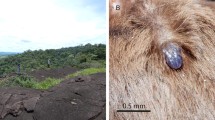Abstract
A hard tick larva in Cretaceous Burmese amber is described as Cornupalpatum burmanicum n. g., n. sp. Diagnostic characters include a subcircular body with a marginal groove, 11 festoons, elongate four-segmented palpi with the fourth segment distinct and apical, the absence of an anal groove and eyes, and the presence of claws on palpal segment 3. The last character is unique for all members of the Ixodida, both fossil and extant. Aside from the palpal claws and marginal groove, features of the tick larva closely resemble those of members of the genus Aponomma Neumann 1899, considered one of the most primitive tick lineages today, whose hosts are primarily reptiles.
Similar content being viewed by others
References
Chhibber, H.L. (1934) The mineral resources of Burma. London: Macmillan & Co., 320 pp.
Clifford, C.M. & Anastos, G. (1960) The use of chaetotaxy in the identification of larval ticks (Acarina:Ixodidae). Journal of Parasitology, 46, 567–578.
Cockerell, T.D.A. (1922) Fossils in Burmese amber. Nature, 109, 713–714.
Cruickshank, R.D. & Ko, K. (2002) Geology of an amber locality in the Hukawng Valley, northern Myanmar. Journal of Asian Earth Sciences (in press).
Grimaldi, D.A., Beck, C.W. & Boon, J.J. (1989) Occurrence, chemical characteristics, and paleontology of the fossil resins from New Jersey. American Museum Novitates, 2948, 28.
Grimaldi, D.A., Engel, M.S. & Nascimbene, P.C. (2002) Fossiliferous Cretaceous amber from Myanmar (Burma). American Museum Novitates, 3361, 71pp.
Hlaing, U.T. (1999) Burmite-Burmese amber. Australian Gemnologist, 20, 250–253.
Hoogstraal, H. & Kim, K.C. (1985) Tick and mammal coevolution, with emphasis on Haemaphysalis. In: Kim, K.D. (Ed.) Coevolution of parasitic arthropods and mammals. New York: John Wiley & Sons, pp. 505–568.
Keirans, J.E., Lane, R.S. & Cauble, R. (2002) A series of larval Amblyomma species (Acari: Ixodidae) from amber deposits in the Dominican Republic. International Journal of Acarology, 28, 61–66.
Krantz, G.W. (1978) A manual of acarology. Second Edition. Corvallis: Oregon State University Book Stores Inc., 509 pp.
Lambert, J.B., Frye, J.S. & Poinar, G.O., Jr (1990) Analysis of North American amber by carbon-13 NMR spectroscopy. Geoarchaelogy, 5, 43–52.
Lane, R.S. & Poinar, G.O., Jr (1986) First fossil tick (Acari: Ixodidae) in new world amber. International Journal of Acarology, 12, 75–78.
Langenheim, J.H. & Beck, C.W. (1968) Catalogue of infrared spectra of fossil resin (ambers). 1. North and South America. Botanical Museum Leaflets, Harvard University, 22, 65–120.
Poinar, G.O., Jr. (1992) Life in amber. Palo Alto: Stanford University Press, 350 pp.
Weidner, H. (1964) Eine Zecke, Ixodes succineus sp. n., in baltischen Bernstein. Veröffentlichen Ñberseemuseum Bremen, 3, 143–151.
Zherikhin, V.V. & Ross, A.J. (2000) A review of the history, geology and age of Burmese amber (Burmite). Bulletin of The Natural History Museum (London)(Geology), 56, 3–10.
Author information
Authors and Affiliations
Rights and permissions
About this article
Cite this article
Poinar, G., Brown, A.E. A new genus of hard ticks in Cretaceous Burmese amber (Acari: Ixodida: Ixodidae). Syst Parasitol 54, 199–205 (2003). https://doi.org/10.1023/A:1022689325158
Issue Date:
DOI: https://doi.org/10.1023/A:1022689325158




